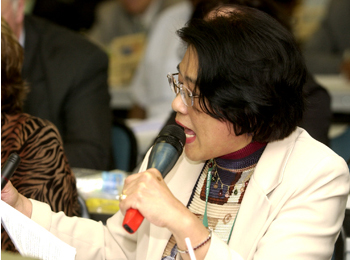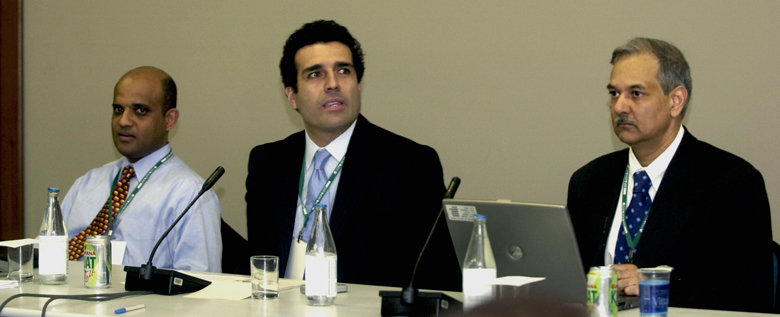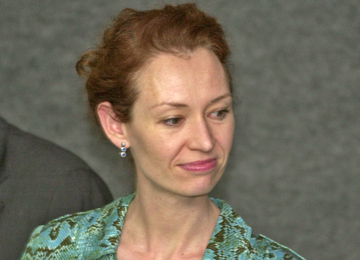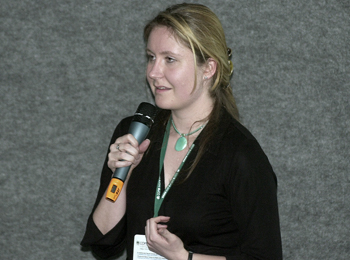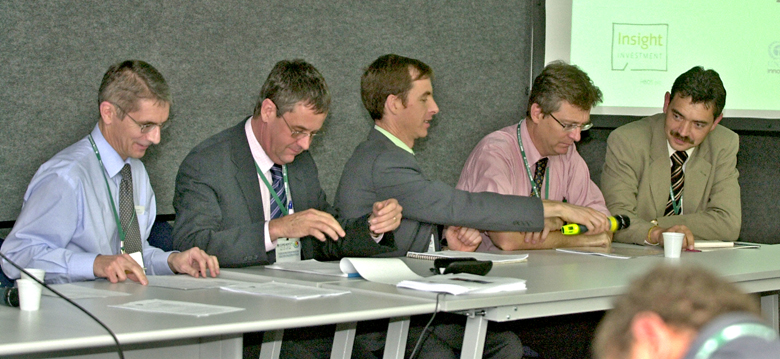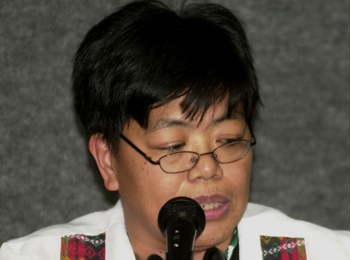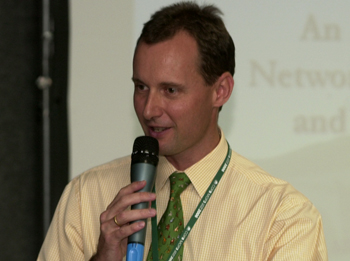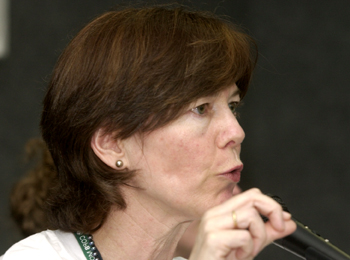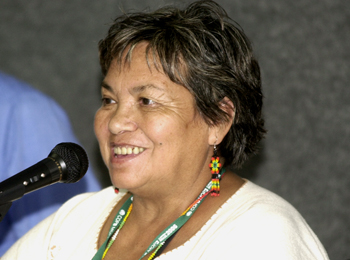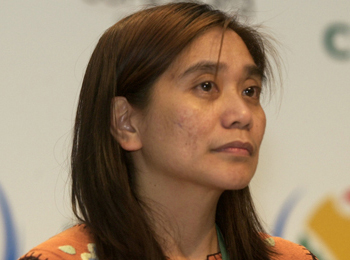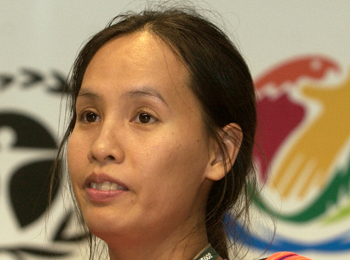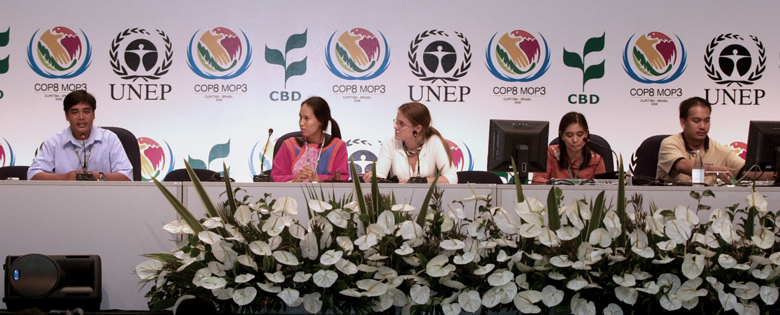 |
||
|
published by IISD, the International Institute for Sustainable Development
in cooperation with the CBD Secretariat |
|||
|
A Special Report on Selected Side Events at CBD COP-8
|
|||||
| 20-31 March 2006 | Curitiba, Brazil | |||||
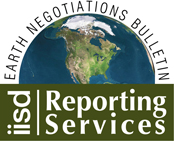 |
 |
||||
 |
|||||
|
United Kingdom Foreign & Commonwealth Office
|
|||||
Events convened on Tuesday, 21 March 2006
|
The GEF Resource Allocation Framework Presented by the Global Environment Facility (GEF) |
|||
|
Ramesh Ramankutty, GEF, provided a background to the development of the Resource Allocation Framework (RAF), its conceptual framework and allocation methodology, and GEF activities to facilitate RAF’s implementation. He explained the RAF had emerged from donor policy recommendations of the 3rd replenishment of the GEF (GEF3) calling for establishment of a system based on global environmental priorities (reflected in the GEF Benefits Index (GBI) indicator) and country level performance (reflected in the GEF Performance Index (GPI) indicator). He further explained that the two focal areas agreed were biodiversity and climate change, and that the RAF will become operational at the beginning of the next GEF replenishment period in July 2006 (GEF4). In explaining the methodology for country allocation, Ramankutty noted the 80/20% weighting between terrestrial and marine endowments for the GBI on Biodiversity (GBIBIO); and that, of the overall biodiversity envelope, 90% of the funding available to donors will be allocated according to the RAF allocation formula on a weighted index. He emphasized that Convention guidance remains the primary determinant for GEF priorities. He outlined measures being undertaken to aid countries in transition to the new system, including programming guidelines, periodic consultations, sub-regional workshops, and country support programmes for GEF focal points. He said the expected amount to be allocated for GEF4 will be based on GEF3 replenishment figures. Ravi Sharma, GEF, provided a more detailed description of GEF activities to aid countries, focal points, NGOs and civil society in the transition to the RAF including: support in the identification of country needs through funding of National Capacity Self-Assessments (NCSA); institutional support and training; GEF focal point training; the small grants programme for civil society; and enabling activities such as support in carrying out and monitoring National Biodiversity Strategy Action Plans (NBSAPs). Regarding GEF activities external to the RAF, he noted special support for Small Island Developing States (SIDS) and Less Developed Countries (LDCs), through a new GEF facility placing less administrative burdens on these countries, and providing programmatic support. Regarding support for the implementation of the Cartagena Protocol on Biosafety, Castro noted promotion of regional projects to encourage pooling of resources and taking advantage of economies of scale. On concerns about the RAF allocation mechanism and pressure being placed on country focal points, Ramankutty stressed the intention is that each country will be able to access a minimum of US$1million and endorsed the new country-led allocation. One participant asked how the GEF will deal with non-allocated funds with Ramankutty responding that RAF programming guidelines suggest countries maintain a ‘project pipeline’ to allow for allocation of unspent funds across the funding cycle, and form regional bidding groups. Castro said that it was hoped that regional approaches will allow for flexibility. Castro concluded the session by urging timely conclusion of replenishment negotiations to allow implementation of the RAF. |
|||
|
|||
|
Protecting Shareholder and Natural Value: The Role of the Finance Sector in Protecting Biodiversity Presented by Fauna and Flora International (FFI), UNEP Finance Initiative, Insight Investment, and VBDO Dutch Association of Investors for Sustainable Development |
|||
|
Christopher Wells, ABN AMRO, explained that externalities such as clean air and stable climates now have cost implications. He added that banks are increasingly interested in clients with the ability to control costs and would want to continue financing them; avoiding those vulnerable to environmental fines and possibly bankruptcy. Kerry ten Kate, Insight Investments, discussed investor responsibility, and explained that as an asset manager, Insight engages with companies, such as pension funds and insurance companies, in which its clients’ investments are held, to encourage them to adopt high standards on ethical, environmental and social issues. She explained how a biological benchmark consisting of a framework that articulates best practice management for biological diversity has been devised in collaboration with FFI. This framework answers questions on how biological diversity translates into specific responsibilities for companies and measures their performance. Annelisa Grigg, FFI, explained that the benchmark had led to change evidenced by a more strategic approach regarding biological diversity and risk. She admitted that significant areas of weakness remained in the areas of risk evaluation, policy development, strategy, assurance and reporting. She also clarified that the benchmark is primarily targeted at the extractive industry. Discussion: Participants acknowledged that the benchmark helps to influence behavior since it deals with commercial risks and is an excellent development tool which provides an incentive for the private sector to develop strategies for sustainable use. |
|||
|
|||
|
Enhancing Indigenous Peoples’ Participation in and Contribution to the CBD and Related Processes through the Indigenous Peoples Network for Change Project Presented by the International Alliance of Indigenous and Tribal Peoples of the Tropical Forests (IAITPTF) |
||
|
While introducing the recently launched Indigenous Peoples Network for Change (IPNC) Project, Minnie Degawan, IAITPTF, highlighted its main objectives, aimed at empowering indigenous peoples’ participation in international processes while facilitating the flow of information back to communities. She stated that the IPNC, as a knowledge network, will assist in building human capital through the provision of training and workshops, while developing solidarity among indigenous peoples.
Vladimir Bocharnikov, RAIPON, described the Information Management System (IMS) under the IPNC, involving community experts, donors, media and indigenous peoples, through the use of baseline information surveys; a web-based database; and GIS mapping functions. Esther Camac, Consejo Indígena Mesoamericano, spoke about challenges in implementing the IPNC, notably on the difficulty in identifying co-financing, and the need to ensure financial sustainability. She described the development of community radio programmes in pilot locations such as Guatemala. Lucy Mulenkei, Indigenous Information Network, spoke on capacity building activities and highlighted partnership as key to getting other stakeholders who are non-members of the alliance to participate and add value to the IPNC. Delfin J. Ganapin, UNEP-GEF Small Grants Programme (SGP), noted that SGP is supporting community action in generating global impact through the empowerment of communities, including projects to improve communication such as community radios. Mario Ramos, GEF Secretariat, noted GEF efforts to create a financing mechanism in support to indigenous peoples’ initiatives. Anamaría Varea, UNDG-SGP, noted the paradox faced by the 12 ethnic groups of indigenous peoples in Ecuador, a megadiverse country with endemic poverty and deforestation affecting the livelihoods of the most vulnerable, and highlighted the importance of IPNC to empower indigenous peoples in finding solutions. |
||
|
|||
|
Terminator Technology- Potential Impacts of Genetic Use Restriction Technologies (GURTS) Presented by the Ban Terminator Campaign |
||
|
Hope Shand, Action Group on Erosion, Technology and Concentration (ETC Group), said if the moratorium on terminator seed technology was defeated it would open the door to terminator seed technology and the planting of “suicide seeds.” She underlined that farmers were losing their right to freely use and develop their crop diversity and that terminator seeds are biological patents without expiration dates. She explained that the CBD COP-5 decision on agricultural biodiversity established a de facto moratorium on GURTS, which is under attack following the recommendation by the Article 8(j) Working Group, which allows a case-by-case assesment of GURTS.
Ricarda Steinbrecher, Eco Nexus, said the socio-economic impacts of terminator seed technology were more important than the scientific impacts. She made the distinction between T GURTs, which control a specific seed trait, and V GURTS, which control the whole reproductive process, and produce sterile seeds. She stressed that the technology was not reliable and highlighted the possibility of leakage leading to seeds that cannot be controlled. Teresiah Ng’anga, Pelum Association and African Biodiversity Network Kenya, reiterated that the sterilization of seeds using genetic engineering was an affront to African women who are seed custodians. She added that terminator technology is dangerous because of the possibility of cross pollination making indigenous seeds sterile. Lisa Saway, Talaandig School for Living Traditions, said that the Talaandig people of the Philippines had been victims of colonization which had destroyed their culture, and that terminator technology represents another threat. She suggested that terminator technology can negatively impact indigenous knowledge, spirituality and self confidence, which amounts to cultural genocide. Francisca Rodriguez, Via Campesina and Association of Indigenous Rural Women (ANAMURI), stressed that it was important to maintain the moratorium on terminator seed technology. She added that conventional seeds are vital for life, and that agrarian land reforms would be undermined by lack of seed sovereignty. |
||
|
|||
|
Natural Resource Management and Indigenous Peoples in Asia and Pacific: Interface of Government Policies with Indigenous Systems Presented by the UNDP Regional Indigenous Peoples’ Programme (RIPP) and the Asia Indigenous Peoples Pact Foundation (AIPP) |
||
|
The event started with a traditional auspicious hymn “Iwassali” by Donato Bayubay Bumacas, Kalinga Mission for Indigenous Communities and Youth Development (KAMICYDI), Philippines, to bless and foster a spirit of cooperation among participants.
Helen Leake, UNDP-RIPP, indicated that the RIPP is working on the interface between government policies and indigenous practice regarding Natural Resource Management (NRM). She noted that NRM is a framework for the interaction of indigenous peoples and governments (with identified positive and negative cases) in both land and resource management and access. She highlighted that UNDP has a Policy of Engagement with Indigenous Peoples based on the principle of free prior informed consent (FPIC), right to development and full development, and inclusion of indigenous perspectives in development planning and management. Highlighting challenges over the management of natural resources, Lourdes Amos, Igorot-Kankanaey, Cordillera, Philippines and AIPP, emphasized issues of state sovereignty within indigenous lands and territories, and the existence of overlapping and conflicting management systems, such as protected areas and indigenous traditional systems. Amos indicated that preliminary findings from case studies on NRM in Bangladesh, Thailand, Cambodia and Malaysia identify key emerging issues, such as governance, related to inclusiveness of NRM systems, structures of support for NRM by indigenous peoples, and the need for inter-ministerial or inter-department cooperation for indigenous rights at national levels. Sharing experiences of indigenous peoples in NRM, Alae (Kamolphan Saelee), Lisu People, Intermountain Peoples Education and Culture in Thailand Association (IMPECT), and Adrian Lasimbang, Kadazan, Sabah, Malaysia, spoke about challenges and gaps at policy and operational levels, emphasizing the lack of recognition of rights to land and free movement. |
||
|
|||
|
||
|
Click the above button to go back to our ENB main coverage
|
||
|
|
|
|
|
||
|

